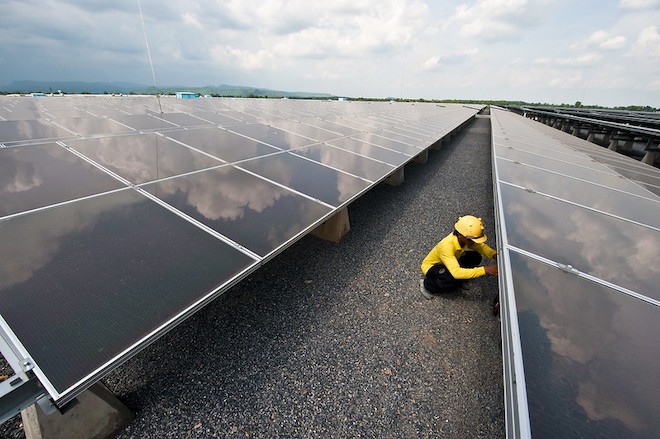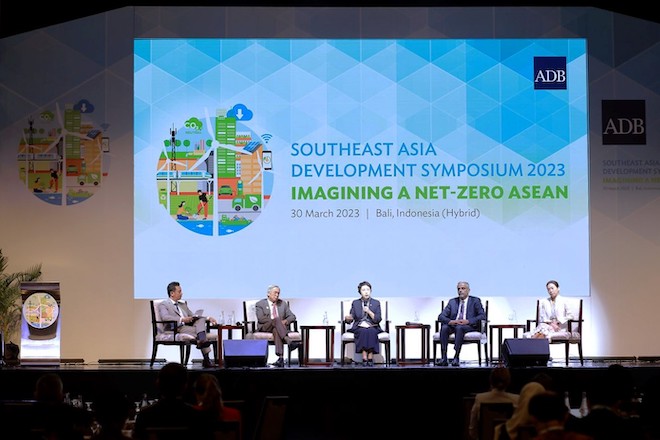
Meeting net-zero targets hinges on how fast both the public and public sectors can mobilize capital to finance climate investments.
The stakes are high, with the latest Intergovernmental Panel on Climate Change (IPCC) report warning the world is already 1.1ºC warmer compared with pre-industrial levels, resulting in more intense extreme weather events, not just in Southeast Asia, but across the globe.
The capital needed to limit warming to 1.5°C is also high, with estimates varying for Southeast Asia. A 2017 report from the Asian Development Bank (ADB) projected the region would need $210 billion per year through 2030 for climate adaptation and mitigation investments. A 2022 report from Bain & Co., Temasek, and Microsoft, on the other hand, estimated the region would need $3 trillion in investment through 2030, which translates to $375 billion annually.
A plenary panel on “Financing Net Zero” organized during the Southeast Asia Development Symposium (SEADS) held in March, warned that existing financing going into the renewable energy sector is not enough. The panel was moderated by Bloomberg TV Anchor and Chief Markets Editor David Ingles.
Citing a Bloomberg study, Glasgow Financial Alliance for Net Zero Asia–Pacific Network Managing Director Yuki Yasui said that at present, the ratio of investments going into fossil fuel and renewable energy sectors is on par. “What we need to do is to bring that to a 4:1 ratio,” she told the panel. For every $1 of existing investment into the fossil fuel industry, $4 will need to be invested into the green economy or the renewable energy sector. “That's quadrupling what is happening today and it is not an easy task,” she said.
ADB Director General and Sectors Group Chief-Designate Ramesh Subramaniam, also one of the panelists, agreed that directing capital into the transition is a major challenge. “It’s so hard even to frame the challenge because the issues are just so complex. We need not just money, but innovative solutions. We need incentives. We need policies.”

Mobilizing private capital
One of the biggest challenges confronting governments is mobilizing private capital to finance the investments needed for decarbonization.
The Glasgow Financial Alliance for Net Zero, a global coalition of leading financial institutions committed to meeting the Paris Agreement target, is among those seeking to mobilize private capital for net zero. The alliance now includes 550 financial institutions with $135 trillion in assets, representing about 40% of global financial assets, said Yasui.
One of the programs the alliance is supporting is the Just Energy Transition Partnership (JETP), a coalition of countries seeking to mobilize $20 billion of public and private funds to help Indonesia retire coal power plants.
Retiring Southeast Asia’s coal plants is key to advancing the region’s net-zero ambitions as coal power accounts for nearly 30% of global carbon dioxide emissions and are predominant in the region’s power generation capacity.
Coal plants in the region are younger than those in the United States and Europe. Yasui said the average age of power plants in Asia is about 13 and in Southeast Asia, 11. In comparison, the average age in Europe is 23 and 33 in the United States.
She warned against letting Asia’s coal power plants live the full years of their useful life of about 40–45 years, as it would mean missing the 1.5ºC Paris Agreement target. “It is in the interest of not just this region, but the whole world to support the early or accelerated retirement of power plants.”
She said ensuring the phaseout is credible is a challenge. “Lack of credibility of a managed phaseout can kill a transaction,” she said, noting financial institutions, especially those that are committed to net zero, are not going to support programs that would be branded as greenwashing.
Ensuring retiring coal assets would be financially viable for both the asset owner and the financiers is another challenge. This would require financial engineering, she said, noting structuring such a deal would need innovative solutions.
The alliance is also looking at the role of blended finance, which uses concessional debt plus a small grant component to reduce the cost of capital in project financing. What is the role of ADB or a G7 country in this matter, asked Yasui, noting such a mechanism can improve risk return, and can also help fund project preparation which can be very costly and high risk, as well as pay for the just transition cost, like reskilling the workforce, among others.
ADB has also launched a mechanism to help accelerate Southeast Asia’s clean energy transition, said Subramaniam. The Energy Transition Mechanism has the potential to accelerate the retirement of coal plants by at least 10 to 15 years on average. He said ADB is also working to improve the bankability of green infrastructure through the ASEAN Catalytic Green Finance Facility. He also cited the Innovative Finance Facility for Climate in Asia and the Pacific, an innovative financing facility ADB recently launched to accelerate billions in climate change financing.
Exchanges also have a role to play in the net-zero transition, said Singapore Exchange Managing Director, Head of Sustainability and Sustainable Finance Herry Cho.
The Singapore Exchange (SGX Group) is part of the Net Zero Financial Service Providers Alliance, which commits members to align their services to net zero by 2050. Two years ago, Singapore Exchange also set up a sustainability department, which reports directly to the group CEO to mobilize sustainability initiatives across the whole organization.
Cho said more needs to be done to help companies, especially, those from hard-to-abate sectors tap the capital markets to raise financing for decarbonization. “If we are to just cut off the capital markets mechanism for the companies in the sectors that are hard to abate completely, you know they will just go elsewhere. They will just go private where there is a lot less transparency,” she warned. “How do we actually then work with the ecosystem so that there are guardrails around over time? How do you look at companies that are hard to abate that want to tap into the capital markets, whether that’s equity or debt? And then how do you actually help provide further transparency?”
Adopting a whole-of-government approach
A whole-of-government approach can help advance countries’ net-zero ambitions. This approach entails different government departments working in sync to implement policies that promote net zero.
The Philippines has adopted such an approach, said Philippine Central Bank Governor Felipe Medalla during the panel discussion.
The Department of Energy has banned new coal plants. In November last year, it also adopted a policy, which opened the renewable energy sector to full foreign ownership. With the move, the government hopes to lure foreign investors to invest in solar, wind, hydro, and ocean or tidal energy projects in the Philippines. The policy measure amended stipulations in the Renewable Energy Act requiring full Filipino ownership of renewable energy resources, such as air, wind, or solar.
“We may also take the same view of the transportation [sector], because these are the two biggest sources of emissions,” said Medalla.
Imposing an excise tax on coal is another policy option the government can study in concert to speed the retirement of coal plants, he said. The country’s move to slap excise tax on cigarettes had discouraged people from smoking, he said, noting a similar effect may happen if there is a tax on coal power. He said, however, for such a policy move to succeed, the government must first ensure renewable energy is available for those seeking cleaner energy options.
The central bank can also play a role in providing the right financing environment for green projects by relaxing lending regulations to direct more financing to green initiatives, said Medalla. For instance, he said the central bank could lighten the restriction on the single borrower’s limit.
Such a policy had been imposed in the past to prevent banks from getting credit exposure from a single borrower, which can increase their credit risk.
But Medalla also conceded it would be difficult to implement such measures, citing as an example the Philippines’ experience in implementing a law that required banks to lend a portion of their loanable funds to farmers and agrarian reform beneficiaries.
The law had an unintended effect as banks opted to pay penalties instead of meeting the lending requirement as they perceive loans to farmers and agrarian reform beneficiaries too risky. “In other words, if the economic incentives aren’t there, it’s very hard to do,” said Medalla.
Banks also need to ensure that when lending, the effects of climate change on the borrower's ability to pay are reflected in the credit risk analysis, he said.
Improving access to capital also entails using a common language, or taxonomy, in financing sustainable projects. “Right now, there are more taxonomies than there are countries,” he said. “We must agree on how precisely the governance and the incentives will be employed. If you cannot even agree on the definition, then you are dead in the water,” he said.
A case for mainstreaming, mobilizing, and messaging
Subramaniam said ADB is helping developing member countries by adopting a three-pronged approach in advancing net zero.
The first entails mainstreaming or integrating climate into anything and everything. “That’s going to be very, very critical, not only in the traditional infrastructure type of sectors such as energy, transport, urban, but also economy-wide transformation [that] needs to take place. Policy, legal and regulatory framework is also very critical," he said.
The second entails mobilizing not just money, but also skills, new ideas, and new technology solutions given the rapidly changing technology landscape. “Not all developing countries are equal, there are lower-income developing countries, even within ASEAN, they need assistance, so how can we mobilize that?”
The third involves clear messaging that "the transition needs to be just and it needs to be affordable,” he said.

